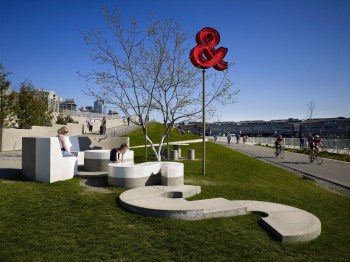Preserving the Piece: Conserving the Olympic Sculpture Park

In light of the re-painting of Alexander Calder’s The Eagle I wondered what it took to keep the art housed at the Olympic Sculpture Park looking like new. I spoke with Liz Brown, one of the museum’s conservators. She gave me some great insight into what it takes to keep the sculptures in the park looking pristine.
Many people may not realize that the work of a conservator is a fine balance of science, art history, and hand skills. The conservators at the museum go through extensive training and education in order to properly strike that balance. Liz Brown explained that, “training in conservation continues during graduate school with summer internships and afterwards, with post- graduation fellowships.” She goes on to mention that courses in chemistry, art history and studio art are also required for entry into graduate school. The care that goes into the conservation of the sculpture park is careful, immense and important as demonstrated by the repainting of The Eagle by Alexander Calder.
About every four years, you might notice that The Eagle turns a salmon color instead of the Calder Red for which it is famous. Why is this? Due to its proximity to Puget Sound, the mixture of sea air and sun tend to rough this sculpture up. The paint that is used is not as durable as newer, more technologically advanced types of paint capable of withstanding the elements.
You might be wondering why the museum doesn’t use a more durable paint. In order to preserve Calder’s original vision for the sculpture, SAM conservation, in consultation with the Calder Foundation, decided to use the original paint that was chosen by Calder in 1971. The mission of the SAM conservators, according to Brown, is “to preserve the artworks as closely to the artist’s intent as possible in order for the current as well as the future generations to enjoy.” The original paint will be used for the foreseeable future until a more durable paint that retains the integrity of the original red is created.
The re-painting of any large sculpture is a huge undertaking and The Eagle is no exception. When asked about the process Liz Brown said, “Years of research go into understanding the nature of the piece and selecting the correct course of action before treatment is started. Once this particular course of action is determined [it] should take this team about two weeks.”
Each piece in the museum’s permanent collection has a different order of care that goes into its preservation. An example would be Persephone Unbound by Beverly Pepper. This sculpture is made of bronze with delicate patina. If bird droppings, salt, or pollutants come in contact with the work they will cause the surface to degrade. If left too long, the piece will corrode. It is important to do spot treatments, regular cleaning and continual research to keep the structure sound, and in line with the artist’s intended vision for future generations to enjoy.
Many of the other sculptures require individual care and Liz and the other conservators invite you “to help [them] in the mission by being sensitive to the, although not immediately apparent, delicate nature of the artworks.”
While talking with Liz, I realized how difficult, ever-changing, and never-ending a conservator’s job is. If you are interested in seeing The Eagle repainted, make sure to visit the Olympic Sculpture Park this week!
– Lindsay Baldwin, Public Relations Intern